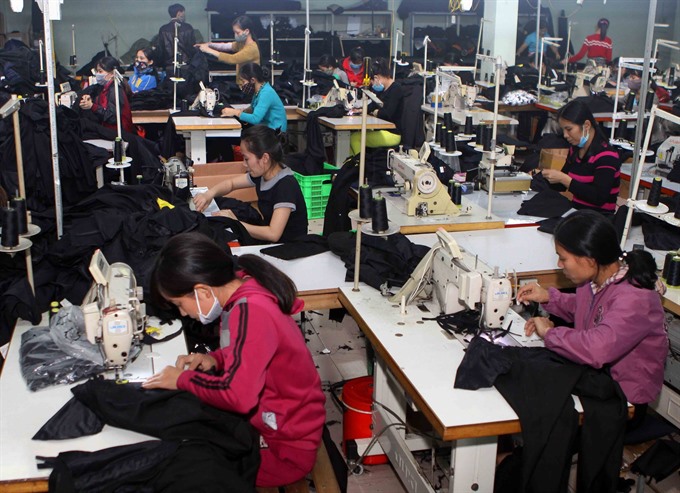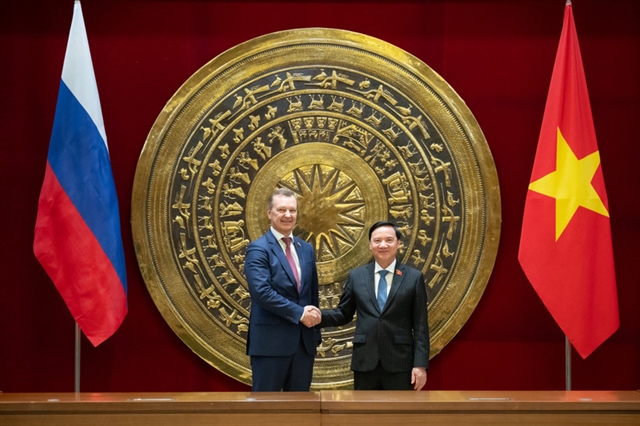 Economy
Economy

Việt Nam’s textile and garment industry targets a year-on-year increase of 10 per cent in export value, to US$34 billion, in 2018.
 |
| Apparel products being made by workers at Thành Đạt garment company in the central province of Nghệ An. - VNA/VNS Photo Thanh Tùng |
HÀ NỘI – Việt Nam’s textile and garment industry targets a year-on-year increase of 10 per cent in export value, to US$34 billion, in 2018.
Lê Tiến Trường, general director of the Việt Nam National Garment and Textile Group (Vinatex), said this target was set despite difficulties in markets at home and abroad. He was speaking at a meeting on reporting Vinatex’s results of production and business in Hà Nội on Tuesday.
In 2018, Việt Nam’s textile and garment industry will face more competition, while other textile exporting countries in the world plan to maintain their market shares in the world garment market, as well as expand their market shares further, Trường said.
The local textile and garment industry must be careful with the anti-dumping story, he said.
To achieve the target of more than 10 per cent growth in 2018, Vinatex’s general director said that the textile and garment industry must make great efforts to focus further on solutions to increase labour productivity.
He said that Việt Nam’s textile and garment industry stands at a good position in the world garment market. The major buyers of the world consider Việt Nam as the supply centre and give priority to Việt Nam in supplying garment products to them.
Vietnamplus quoted Trường as saying that "Việt Nam is the world’s largest producer of men’s and women’s suits.”
“Moreover, Việt Nam has had experience in converting from a production method of processing to an FOB (free on board) and ODM (original design manufacturer). Now, the processing has reached only 30-35 per cent of production, while FOB has accounted for 55-60 per cent and ODM producing textile and garment products, from designing to finished-products, has occupied 10 per cent," he said.
In addition, the industry should continue to invest in technology development to create stability, sustainability and efficiency in development of the textile and garment industry, he said.
Exports in 2017
Last year, the textile and garment industry gained a year-on-year increase of 10.23 per cent in the export value of textile and garments to $31 billion, higher than its target set at the beginning of the year at $30 billion.
Major markets of the United States, the European Union, Japan and South Korea maintained good growth, while there were breakthroughs in exports to other markets such as China, Russia and Cambodia, according to Trường.
The South Korean market jumped to the fourth position, close to the Japanese market, reaching an export value of $2.7 billion in 2017. Việt Nam’s textile and garment exports to China in 2017 reached $3.2 billion, the same as the export value to Japan.
Meanwhile, Trường said the domestic textile and garment market also gained a year-on-year growth rate of 10 per cent in 2017.
The balance in development of the domestic market and the export market has been an important point for the local textile and garment industry to ensure jobs for the employees and to maintain development of the enterprises, he said.
Vinatex’s total revenue increases
During the meeting, Vinatex reported its total revenue in 2017 was estimated to have increased year-on-year at 10.7 per cent to VNĐ45.55 trillion ($2.02 billion). Of this, domestic sales reached VNĐ10.39 trillion, accounting for 22.8 per cent of the total revenue, 10.6 per cent higher than the revenue in 2016.
The pre-tax profit in 2017 reached VNĐ1.43 trillion, according to the group.
Vinatex set a revenue target of VNĐ48.5 trillion, a year-on-year surge of 6.5 per cent and a pre-tax profit of VNĐ1.45 trillion in 2018.
This year, the group will also implement the divestment, according to the decision of the Prime Minister. The Ministry of Industry and Trade will withdraw its investment at 53.5 per cent of Vinatex’s shares from the group this year. - VNS




